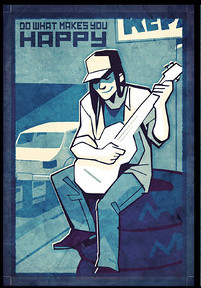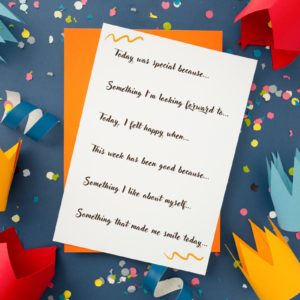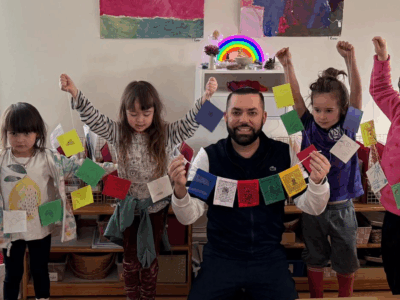Creating and Using Joy Jars with Children

About This Resource
Details
Creating and Using Joy Jars with Children

Creating a joy jar (also known as a happy jar, gratitude jar, or treasure jar) is excellent way of helping connect ourselves and children with sources of positive energy. Research strongly suggests that practicing gratitude, or recognizing sources of joy has a strong effect on our health and wellbeing. There are countless examples of how to make these jars around the internet, while most of them share some common ideas.
-
-
-
- When you begin the conversation about this project with children, consider starting by asking, “What is one thing that made you smile today?” or “What are you thankful for today?” Or just “What makes you happy?”You can of course share your own examples as a way of getting the conversation going.
- You will need some kind of empty jar or container. Many recommend plastic, such as from an empty mayonnaise or peanut butter jar, as it’s less likely to break with daily handling. If you prefer, you could also use a box, or temporarily, or when traveling—an envelope—they key is that it should inspire you.
- Decorate it, and make it beautiful. Think: glitter, tissue paper, buttons, photos, magazines… the idea is to make it meaningful for everyone who is using it. Invite children to generate ideas about how to decorate it. Giving kids choice is so valuable. Variations are endless. Keeping the jar in a special place, where they will often see it is another way of keeping it in mind, and giving it positive associations.
- Kick-off the practice as a group. Practice adding to it regularly, (ideally every day). Make it a ritual that you take a little time to do with others. This could be as a family at the end of the day, or as a classroom at the end of the day or even the end of the week.
- Make it easy by preparing slips of paper ahead of time. These could be blank slips of paper or slips of paper with a variety of prompts that you print and have in a box with pencils nearby. This pdf has three pages of ideas ready to print. Drawing representations is a wonderful option that can be even easier for children to connect their positive feelings with, so consider that when you are deciding the shape and size of the paper you want to provide. For very young children, you can also of course write what they say.

- You can use the jar as a resource sometimes when you need a lift, for example if someone in your family or classroom is having a hard day. Reflecting on the things that bring us joy when we are troubled can be a resource for re-connecting with our own basic goodness. Also simply pulling some notes out periodically after the jar has started filling up can be a great way of self-reflecting, regardless of your mood.
- Include families. Perhaps after having done the activity for a month or so, share some highlights of the experience with them in a family letter, and include some basic tips for how to get started, or even refer them to this resource.
- In the classroom, you can consider having each child make their own joy jar, or you could make one large jar that you share as a classroom, consider what you think will work best for your community and personal preferences. If you use a large jar, you will likely want kids to sign their contributions, though it’s not essential—just something to consider.
 Variations that extend beyond the basic ideas of joy, happiness and gratitude include accomplishments, where students record things that they have done that gave them a sense of pride ands satisfaction. This can be a great resource when they are feeling discouraged, and help build confidence. Another theme is recognizing acts of kindness, either kindness that they received from others. This practice could really nicely be integrated with loving-kindness practice that Gregory Kramer articulates in his book we wrote about here.
Variations that extend beyond the basic ideas of joy, happiness and gratitude include accomplishments, where students record things that they have done that gave them a sense of pride ands satisfaction. This can be a great resource when they are feeling discouraged, and help build confidence. Another theme is recognizing acts of kindness, either kindness that they received from others. This practice could really nicely be integrated with loving-kindness practice that Gregory Kramer articulates in his book we wrote about here.This practice can be thoughtfully linked with the Middle Way Education Dharma Fundamentals, including the Four Immeasurables, and the Six Paramitas. It can also be supportive of the MWE domain of fire as we help children express themselves authentically, and of space, as we guide them to contemplate and be aware of their own emotions. It may be most strongly linked with the Earth element, as it helps support appreciation and connection, as we recognize how just like me, my friends’ sources of joy are dependent upon so many beings and things in our environment.
There are countless resources available online. Thank you in particular for some great ideas to: Girls on the Run, PBS Kids, Blissful Kids, Good2KnowNetwork, and CocoStudio.
Image credits: Katja Linders, Juhan Sonin, Doug88888.
-
- This activity may support the MWE domain of fire as we help children express themselves authentically, and of space, as we guide them to contemplate and be aware of their own emotions. It may be most strongly linked with the Earth element, as it helps support appreciation and connection, as we recognize how just like me, my friends’ sources of joy are dependent upon so many beings and things in our environment.
-

